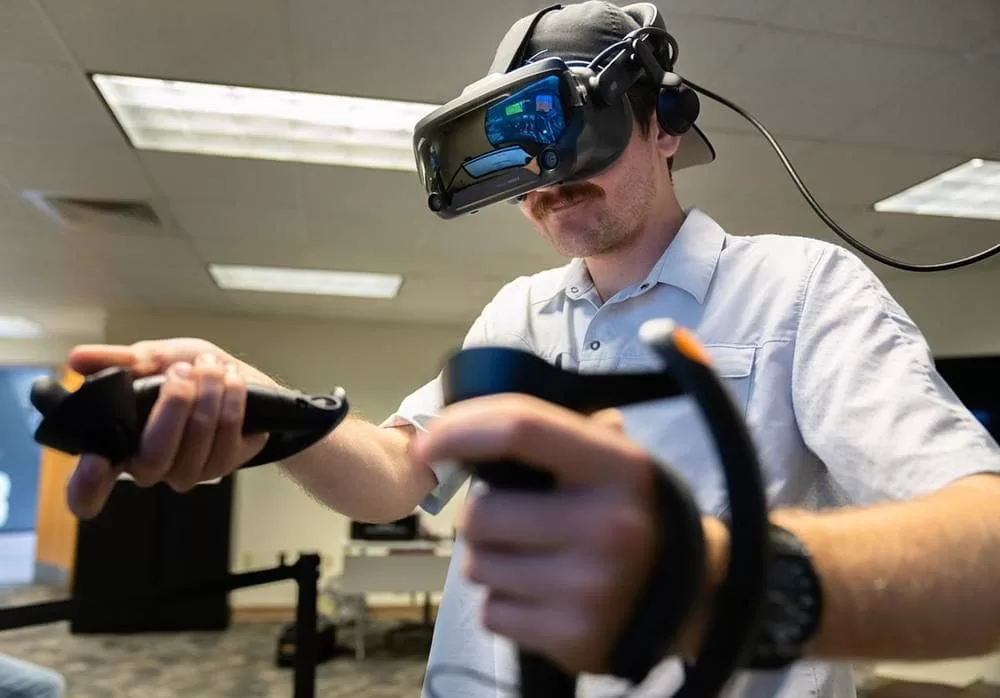Performance and safety are critical in the aviation industry. Aviation training is undergoing a substantial transformation because to training simulations utilizing virtual reality (VR) and augmented reality (AR). With the help of these cutting-edge technology, pilots may train, educate themselves, and be ready for challenging flying situations in a realistic and engaging setting. We’ll go over the significance, advantages, and potential future applications of VR and AR training for pilots in this extensive tutorial.
Table of Contents
- Introduction
- The Importance of VR and AR Training for Pilots
- Benefits of VR and AR Training for Pilots
- Examples of VR and AR Training Simulations for Pilots
- The Future of VR and AR Training for Pilots
- Conclusion: The Future of Aviation Training
1. Introduction
Aviation is an industry where precision and competence are non-negotiable. As aircraft become more advanced, so must the training methods for pilots. VR and AR training simulations offer a promising solution by providing an immersive learning environment.
2. The Importance of VR and AR Training for Pilots
The safety of passengers and the effectiveness of flights are the pilots’ responsibilities. They must have a thorough grasp of aircraft systems and procedures in addition to the capacity to act quickly and decisively under pressure to do this job. Conventional pilot training is necessary but has its limits. It frequently requires costly and time-consuming flight simulators.
VR and AR training simulations are crucial because they:
- Create realistic 3D models of aircraft cockpits and flight environments.
- Overlay digital information onto the real world, aiding pilots in decision-making.
3. Benefits of VR and AR Training for Pilots
3.1 Improved Training Efficiency and Effectiveness
VR and AR training simulations accelerate the learning process, enabling pilots to master new procedures and enhance their skills more efficiently compared to traditional methods.

3.2 Reduced Risk of Accidents and Incidents
These simulations help pilots identify and respond to potential hazards and emergencies, significantly reducing the risk of accidents and incidents during real flights.
3.3 Increased Pilot Confidence
VR and AR training simulations build pilots’ confidence by providing them with the skills and experience to navigate complex flight scenarios effectively.
4. Examples of VR and AR Training Simulations for Pilots
Several VR and AR training simulations cater to pilots’ needs, including:
4.1 VR Flight Simulator
A versatile VR simulator that allows pilots to practice flying a range of aircraft in various flight conditions.
4.2 AR Cockpit Display
This AR system overlays critical digital information onto the real world, such as instrument readings and flight navigation data, enhancing situational awareness.
4.3 VR Emergency Procedures Simulator
A VR simulator that lets pilots practice handling emergency situations, such as engine failures and fires, preparing them for real-life emergencies.
5. The Future of VR and AR Training for Pilots
Although VR and AR training simulators are still in their infancy in the aviation sector, they have the potential to completely transform pilot training. We may anticipate the development of increasingly complex and lifelike training simulators as technology progresses, which will increase the effectiveness and safety of aviation training.
Certainly! Here are some frequently asked questions (FAQs) regarding VR and AR training for pilots:
Frequently Asked Questions (FAQ’s)
1. What is VR and AR training for pilots?
Virtual Reality (VR) and Augmented Reality (AR) training for pilots involves the use of immersive technology to create realistic flight simulations. VR immerses pilots in a fully virtual environment, while AR overlays digital information onto the real world, enhancing training and decision-making.
2. How does VR and AR training benefit pilots?
VR and AR training enhance pilot skills by providing a realistic environment to practice, learn, and make quick decisions. It reduces the risk of accidents and incidents, ultimately increasing pilot confidence and readiness for complex flight scenarios.
3. What specific benefits do VR and AR training offer?
VR and AR training simulations offer improved training efficiency and effectiveness, reduce the risk of accidents, and boost pilot confidence. They enable faster skill acquisition, identification of potential hazards, and preparedness for emergencies.
4. Are there different types of VR and AR training simulations for pilots?
Yes, there are various types of VR and AR training simulations. VR flight simulators allow pilots to practice flying different aircraft, while AR cockpit displays overlay critical information onto the real world. VR emergency procedures simulators help pilots prepare for emergency situations.
5. How do VR and AR training simulations work?
VR simulations create realistic 3D models of aircraft cockpits and flight environments, while AR overlays digital information, such as instrument readings and navigation data, onto the real world. These technologies offer hands-on training experiences for pilots.
6. Are VR and AR training simulations affordable for pilot training?
While initial setup costs may exist, VR and AR training simulations often prove more cost-effective in the long run, as they reduce the need for expensive and time-consuming traditional training methods.
7. What is the future of VR and AR training for pilots?
As technology continues to advance, we can expect even more sophisticated and realistic training simulations. These innovations will contribute to safer skies, more skilled pilots, and a revolution in aviation training.
8. How can I explore opportunities in aviation training and technology?
To explore opportunities in aviation training and technology or to learn more about VR and AR training for pilots, feel free to connect with us on Upwork. We offer tailored solutions and expertise in this field.
6. Conclusion: The Future of Aviation Training
VR and AR training simulations are ushering in a new era in aviation training. They offer improved efficiency, reduced risk, and increased pilot confidence. As technology continues to evolve, the aviation industry can look forward to safer skies and more capable pilots.
For more information or to explore opportunities in aviation training and technology, don’t hesitate to reach out or connect with me on Upwork for tailored solutions. Hire me on Upwork.

